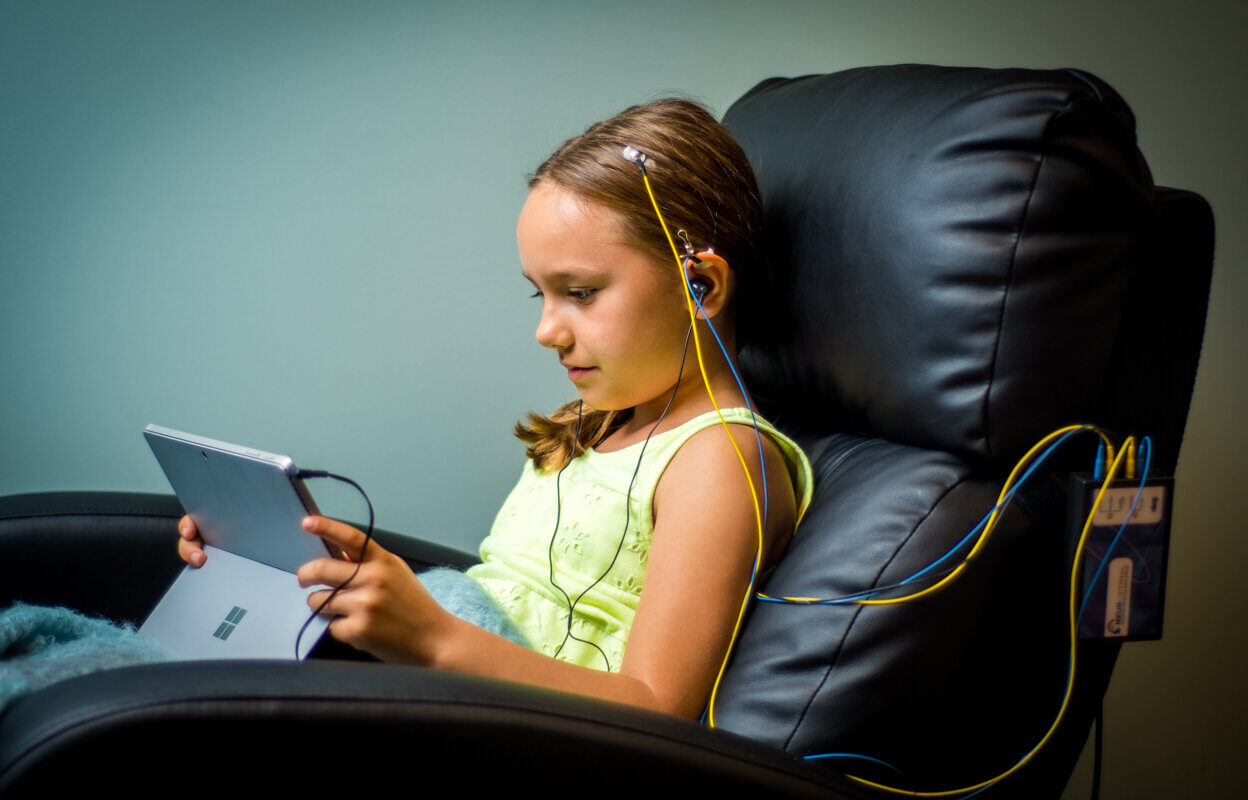Introduction to Neurofeedback
Neurofeedback, also known as EEG biofeedback, is a type of biofeedback that uses real-time displays of brain activity—most commonly electroencephalography (EEG)—in an effort to teach self-regulation of brain function. During neurofeedback training, sensors are attached to the scalp to monitor electrical activity in the brain. Activity is then displayed on a computer screen as visual or auditory feedback, such as graphs or video games.Trainees learn to control the feedback by watching for changes associated with specific mental strategies or states. Through this trial-and-error process, they receive feedback on their brain activity and learn how to adjust it. Over many sessions, the goal is to reinforce desirable brain wave patterns and reduce undesirable ones.
How Neurofeedback Works
Neurofeedback training utilizes brainwaves, which are electrical impulses produced by the firing of neuronal networks in the brain. These EEG signals can be measured by sensors, or electrodes, placed non-invasively on the scalp.
During a neurofeedback session, brainwave activity is visually or audibly fed back to the individual in real-time. For example, EEG sensors may measure activity in the theta range, which has been associated with drowsiness or lack of focus. When theta increases above a set threshold, the feedback—like a video game or light display—may pause until activity decreases. This reinforcement teaches the brain to adjust its electrical output in a targeted area.
Through trial and error over dozens of sessions, the goal is to enable individuals to learn to voluntarily self-regulate their brain function. Advocates believe neurofeedback can help retrain dysfunctional patterns—potentially addressing issues like attention problems, anxiety, depression and more. Results also seem to last well beyond therapy.
Neurofeedback Applications
Attention deficit hyperactivity disorder (ADHD): Several studies have found neurofeedback training can help reduce symptoms ofADHDlike inattention, impulsivity and hyperactivity. Gains are often on par with medication but with less side effects.
Anxiety disorders: Research suggests neurofeedback may lower physiological arousal and anxiety. It aims to reduce overactivity in the right frontal cortex linked to anxious thoughts and increase left-sided activity associated with relaxation.
Depression: Neurofeedback targets patterns tied to depression, like high activity in the right frontal cortex. Studies have found reductions in depressive symptoms post-therapy that are maintained long-term without drugs.
Autism spectrum disorder: Some research links autism symptoms to an underactivated sensory cortex. Neurofeedback attempts to increase sensory-motor rhythm activity here through operant conditioning games. Early results are promising.
Epilepsy: For epilepsy patients who don’t respond well to medications, neurofeedback may help decrease seizure activity by regulating abnormal brain waves which trigger seizures. More research is still needed though.
Traumatic brain injury: Neurofeedback could aid rehabilitation after TBI by helping compensate for damaged areas and improving communication between regions. Increased focus and reduced impulsivity are common therapeutic goals.
Mechanisms of Neurofeedback
While the exact mechanisms of neurofeedback are still being explored, research suggests several reasons why it may prove effective:
– Neuroplasticity: The brain has an innate ability to reorganize and form new connections based on experiences. By rewarding particular EEG patterns, neurofeedback may drive plastic changes linked to improved regulation.
– Operant conditioning: Like any biofeedback, neurofeedback utilizes operant conditioning principles. Training people to control their brain waves strengthens neural networks involved in self-modulating those signals.
– Compensation: For certain conditions, neurofeedback enables compensation by boosting activity in brain areas not damaged rather than trying to fix impaired regions directly. This may confer benefits.
– Increased self-awareness: Repeated exposure to one’s own brainwave activity enhances consciousness of internal states. Learning to control these patterns improves self-regulation over time.
– Normalization: dysfunctional brain wave patterns associated with issues like ADHD or anxiety seem to normalize with neurofeedback—potentially resolving root causes rather than just symptoms.
The Growth of Neurofeedback Research and Use
While neurofeedback has existed since the 1960s, it is only more recently experiencing growing research support and clinical acceptance. Reasons for this include advances in EEG technology now enabling real-time displays, and clearer insights into how brain function relates to various disorders.
Several major reviews and meta-analyses in reputable journals have concluded neurofeedback produces meaningful improvements for ADHD, anxiety, PTSD, and other issues. It also generally outperforms control conditions lacking biofeedback training. Such findings are expanding the scope of conditions treated and number of clinicians offering neurofeedback.
Insurance companies have also begun covering neurofeedback more often based on its clinical evidence. And professional neurofeedback organizations like the Biofeedback Certification International Alliance have established credentialing and practice standards for the field.
As the body of rigorous research expands in coming years, it’s likely neurofeedback will gain greater mainstream acceptance—enabling many more patients access treatment for optimal brain health, focus and emotional well-being naturally through mind-body self-regulation techniques.
Neurofeedback utilizes real-time displays of EEG activity to teach individuals voluntary control over their brain waves. By operantly conditioning neural networks, it aims to address various disorders through plastic changes, compensation, and improved self-monitoring/regulation. Research support is mounting that neurofeedback produces durable benefits for issues like ADHD, anxiety and depression superior to no treatment or relaxation. As technology advances, clinical trials expand, and acceptance grows—neurofeedback promises increasing promise as a drug-free approach for optimizing mental wellness.
*Note:
1. Source: Coherent Market Insights, Public sources, Desk research
2. We have leveraged AI tools to mine information and compile it.


